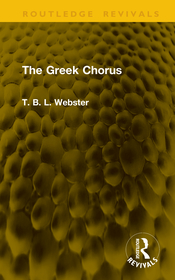
The Greek Chorus
Series: Routledge Revivals;
- Publisher's listprice GBP 90.00
-
42 997 Ft (40 950 Ft + 5% VAT)
The price is estimated because at the time of ordering we do not know what conversion rates will apply to HUF / product currency when the book arrives. In case HUF is weaker, the price increases slightly, in case HUF is stronger, the price goes lower slightly.
- Discount 10% (cc. 4 300 Ft off)
- Discounted price 38 698 Ft (36 855 Ft + 5% VAT)
Subcribe now and take benefit of a favourable price.
Subscribe
42 997 Ft

Availability
Not yet published.
Why don't you give exact delivery time?
Delivery time is estimated on our previous experiences. We give estimations only, because we order from outside Hungary, and the delivery time mainly depends on how quickly the publisher supplies the book. Faster or slower deliveries both happen, but we do our best to supply as quickly as possible.
Product details:
- Edition number 1
- Publisher Routledge
- Date of Publication 1 December 2025
- ISBN 9781041161301
- Binding Hardback
- No. of pages248 pages
- Size 216x138 mm
- Language English 700
Categories
Short description:
Originally published in 1970, The Greek Chorus is primarily concerned to relate the history of the dance, an aspect of the chorus which had so far been inadequately presented. The author describes the visual appearance of the chorus on Greek vases and reliefs from the eighth to the fourth century B.C.
MoreLong description:
The Greek chorus was an essential part of Greek life. It varied in scale from the tiny festival conducted by the family to the choruses of fifty men or boys which competed in honour of Dionysos at Athens, and in tone from the songs in honour of athletic victories to the solemn tragic choruses of Aeschylus or the comic choruses of Aristophanes. By means of the surviving texts and pictures, and the accounts of ancient authors. Its history can be traced from pre-Greek times to the Hellenistic age.
Originally published in 1970, this book is primarily concerned to relate the history of the dance, an aspect of the chorus which had so far been inadequately presented. The author describes the visual appearance of the chorus on Greek vases and reliefs from the eighth to the fourth century B.C. He then discusses the choral performances themselves, with reference to the literary sources, and emphasis is given here to the development of the metre, which was fundamental in providing the rhythm for words, music and dance. In some cases, where we have both textual and pictorial evidence, we can visualize the chorus and at the same time discover the tempo of their dance.
The interplay of the traditional and the original is of great importance to the development of the Greek chorus. Professor Webster explains how far the Greek chorus was based on tradition, when and where innovations were made, and to what extent different types of chorus influenced each other.
MoreTable of Contents:
List of Illustrations. List of Abbreviations. Introduction. Part I: The Archaeological Material 1. Introduction 2. Down to the Time of Homer 3. Seventh Century 4. Archaic 5. Ripe Archaic 6. Early Classical 7. Classical 8. Free Period 9. Later Part II: Literary Sources 1. Down to the Time of Homer 2. Seventh Century 3. Archaic Period, 600–530 B.C. 4. Ripe Archaic Period, 530–480 B.C. 5. Early Classical Period, 480–450 B.C. 6. Classical Period 450–425 B.C. 7. Free Period, 425–370 B.C. 8. Later Part III: Conclusion. Glossary of Metrical Terms. Index.
More



